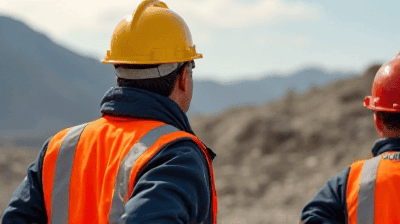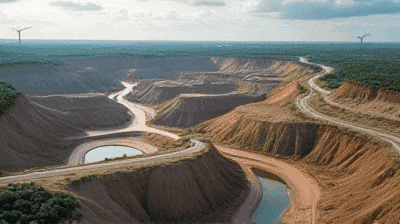
Mining has long been a cornerstone of global economic development, providing essential materials for construction, technology, energy, and transportation. However, the industry has also been associated with significant environmental harm, including habitat destruction, water pollution, and greenhouse gas emissions. As awareness of the environmental impacts of mining grows, the industry faces increasing pressure to adopt more sustainable practices.
Mining activities can have profound ecological consequences. Some of the most significant environmental challenges associated with mining include:
Land Degradation: Mining operations can lead to extensive land disturbance, including deforestation and soil erosion, which disrupts ecosystems and depletes biodiversity.
Water Pollution: Runoff from mining sites carries harmful chemicals into nearby water sources, affecting aquatic life and local communities. Heavy metals such as lead and mercury can contaminate drinking water.
Greenhouse Gas Emissions: Mining processes are energy-intensive, often relying on fossil fuels. This contributes to greenhouse gas emissions, exacerbating climate change.
Waste Generation: The extraction and processing of minerals result in large volumes of waste material, which can lead to contamination and require careful management to prevent environmental damage.
Biodiversity Loss: The destruction of habitats for mining operations negatively impacts wildlife and reduces biodiversity, disrupting ecosystems.
In light of the environmental challenges posed by mining, there is an urgent need to shift towards more sustainable practices. This involves minimizing harm, restoring ecosystems, and ensuring that communities benefit from mining activities. The future of mining will depend on the successful integration of sustainability principles into all aspects of the industry.

The future of mining lies in the adoption of innovative technologies and practices that prioritize environmental stewardship. Key areas of innovation include automation, digitalization, waste management, and sustainable resource extraction.
The integration of automation and digital technologies is transforming the mining sector, enhancing efficiency while simultaneously reducing environmental impacts.
Improved Safety: Automation reduces the need for human intervention in hazardous environments, decreasing accident rates and improving worker safety.
Precision Mining: Technologies such as remote sensing and automated drilling enable more precise extraction of minerals, minimizing waste and reducing the environmental footprint.
Data Analytics: Digital platforms and data analytics allow companies to monitor environmental impacts in real time, enabling prompt responses to potential issues.
Predictive Maintenance: Using algorithms to predict equipment failures can extend the lifespan of machinery, minimizing resource waste and energy consumption.
Advancements in resource extraction methods are crucial for minimizing environmental damage while maintaining productivity.
Selective mining techniques aim to extract only the targeted minerals, reducing the amount of waste material generated in the process. This approach minimizes land disturbance and preserves surrounding ecosystems.
Bioleaching involves using microbial processes to extract metals from ore. This method reduces the need for harsh chemicals and minimizes waste, making it a more sustainable alternative to traditional extraction methods.
In-situ recovery (ISR) is a mining technique that involves extracting valuable materials directly from underground without significant land disturbance. ISR minimizes surface disruption and reduces water usage compared to conventional mining methods.
Effective waste management strategies are essential for reducing the environmental impact of mining operations. Many companies are focusing on recycling and repurposing waste materials.
Tailings—the waste materials left after extracting valuable minerals—can pose significant environmental risks. Effective tailings management strategies, such as:
Stabilization: Techniques for solidifying tailings can prevent the release of contaminants into the environment.
Reprocessing: Mining companies are increasingly exploring the potential for reprocessing tailings to recover additional valuable minerals, reducing waste and maximizing resource efficiency.
Tailings Repositories: Designing safe, sustainable repositories for storing tailings can help prevent water pollution and safeguard local ecosystems.
The mining industry is beginning to embrace circular economy principles, focusing on recycling materials and reducing waste. By investing in technologies that enable the recycling of metals, companies can minimize the extraction of virgin resources and reduce environmental harm.
Water is a critical resource in mining operations, and its management is essential for minimizing environmental impacts. Sustainable water management practices include:
Water Recycling: Implementing systems to recycle water within mining processes can significantly reduce freshwater consumption and minimize the environmental impact on local water sources.
Water Treatment Technologies: Advanced water treatment technologies can mitigate pollution risks by treating wastewater before it is discharged into the environment.
Monitoring and Reporting: Regular monitoring of water quality and usage helps identify potential risks and ensures compliance with regulatory standards.
In addition to technological advancements, community engagement and corporate social responsibility (CSR) are critical components of sustainable mining practices. Building positive relationships with local communities can enhance trust, ensure social license to operate, and contribute to long-term sustainability.
Engaging local communities in the decision-making process ensures that mining operations align with their needs and values. Strategies include:
Consultation and Communication: Mining companies should establish open lines of communication with local stakeholders, allowing for input and feedback throughout the mining project lifecycle.
Community Development Programs: Investment in local infrastructure, education, and health initiatives can enhance the quality of life for affected communities, fostering goodwill and cooperation.
Job Creation: Prioritizing local hiring and training programs helps ensure that local residents benefit from mining activities while building skills for long-term employment.
Mining companies must commit to environmental stewardship as part of their corporate social responsibility initiatives:
Biodiversity Conservation: Implementing strategies to protect and restore local ecosystems can mitigate the impact of mining on biodiversity.
Restoration Programs: After mining operations conclude, companies should engage in reclamation efforts to restore landscapes and habitats, ensuring the environment is returned to a healthy state.
Sustainability Reporting: Transparent reporting of environmental performance and sustainability initiatives demonstrates a commitment to responsible mining practices and builds trust with stakeholders.

The role of regulatory frameworks and industry standards is crucial in shaping sustainable mining practices. Governments, international organizations, and industry bodies must collaborate to establish guidelines that promote responsible mining.
Strong and enforceable regulations can help mitigate the environmental impacts of mining. These regulations should address:
Environmental Impact Assessments: Mandatory assessments must be conducted before mining projects are approved, evaluating potential environmental risks and mitigation measures.
Monitoring and Compliance: Regulatory bodies should implement monitoring programs to ensure compliance with environmental standards, taking corrective action when necessary.
Industry-driven standards can play a vital role in promoting sustainability. Organizations such as the International Council on Mining and Metals (ICMM) and the Extractive Industries Transparency Initiative (EITI) promote best practices and sustainability initiatives that members can adopt.
International agreements and partnerships can foster collaboration on sustainable mining practices. Programs such as the Responsible Mining Index and the Global Reporting Initiative provide frameworks for companies to measure and report on their sustainability performance.
Innovations in technology continue to revolutionize the mining industry, helping to reduce its environmental impact. Some promising technologies include:
Remote sensing and drone technology enable mining companies to monitor environmental conditions, assess land degradation, and track wildlife populations in real-time. This data can inform decision-making and facilitate better environmental management.
AI and machine learning can be utilized to optimize mining operations, enhance resource extraction efficiency, and reduce energy consumption. By leveraging data analytics, companies can identify areas for improvement and develop targeted strategies to minimize environmental harm.
Blockchain technology can enhance transparency in the supply chain, allowing stakeholders to trace the origins of minerals and ensure ethical sourcing practices. By promoting accountability, blockchain can help mitigate illegal mining practices and promote responsible resource extraction.
The transition to electric and hybrid mining equipment can significantly reduce greenhouse gas emissions associated with mining operations. These technologies are more efficient than traditional diesel-powered machinery, resulting in lower fuel consumption and reduced air pollution.

As the mining industry evolves, several emerging trends will shape its future:
The mining sector is increasingly turning to renewable energy sources such as solar, wind, and hydropower to power operations. This transition can reduce reliance on fossil fuels and decrease the industry's carbon footprint.
The development of circular mining initiatives will continue to gain momentum, focusing on reclaiming resources, reusing materials, and reducing waste. This approach aligns with broader circular economy principles, promoting sustainability throughout the entire lifecycle of minerals.
Collaborative approaches among stakeholders, including governments, NGOs, and local communities, will become more common as the industry works to address environmental challenges and implement sustainable practices.
As consumers become more environmentally conscious, companies will face increased pressure to demonstrate their commitment to sustainability. Enhanced transparency in reporting and supply chain practices will be essential for building trust with consumers and stakeholders.
The continued development and adoption of eco-friendly technologies will drive innovation in sustainable mining practices. Investing in research and development will be integral to finding new solutions to reduce environmental impacts.
The future of mining hinges on the industry's ability to adapt to emerging environmental challenges while continuing to supply essential resources. By embracing innovative technologies, sustainable practices, and community engagement, the mining industry can significantly reduce its environmental harm and play a key role in the transition to a more sustainable future.
As the demand for minerals and resources continues to grow, the emphasis on responsible mining practices will become increasingly important. Through collaboration with stakeholders, investment in new technologies, and a commitment to sustainability, the mining industry can reshape its legacy and contribute positively to the planet and society.
The journey towards a more sustainable mining future is not without its challenges, but with dedication and innovation, the industry can rise to the occasion, ensuring that mining not only serves current needs but also preserves the environment for future generations.